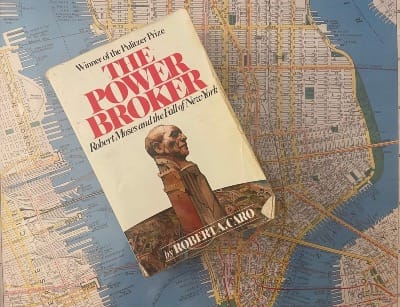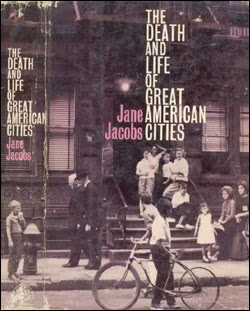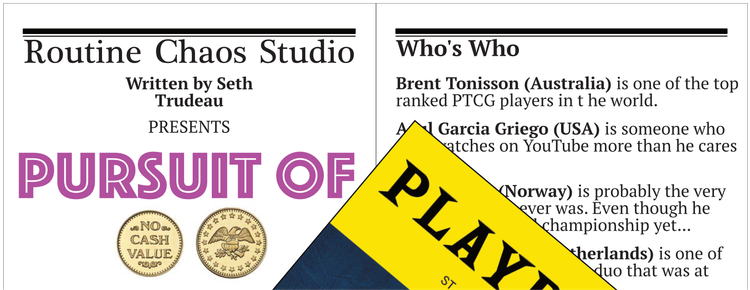Jane Jacobs lives rent free in my head

It’s been quiet around here lately, huh?
I’d love to tell you it’s because I’ve just been sooooo busy, but don’t we all always feel just soooooo busy and still manage to do things?
You know what it really is? It’s The Power Broker, Robert Caro’s epic biography of Robert Moses and how he shaped the New York City metro area. It had been sitting on my “to read” list for over half a decade, and I finally picked it up at the beginning of this year [1] , and I finished it at about the same time that this here newsletter went into a bit of a drought. That’s not coincidental. Caro dredged up a lot of thoughts & ideas for me, and I’ve been trying to work through them & shape them into something coherent…but I’m still not there yet.

And it’s Jane Jacobs’s fault.
I would never have been drawn to The Power Broker without her magnum opus The Death and Life of Great American Cities, but 6 years ago I powered my way through it and it has shaped how I see and interact with the world almost constantly ever since. That social media trend from a few months ago about “ask your boyfriend/husband how often he thinks about the Roman Empire” - in my case, it’s fortunate that Sarah didn’t ask me how often I think about Jane Jacobs [2] .

I’m not going to recap the ideas & arguments she puts forth in that book, because someone else has certainly done it better than I ever could…but I do want to share a few recent anecdotes, because I feel like I’m seeing Jane Jacobs show up more & more and have a feeling that the idea of organic humanism that was coined by her contemporary Lewis Mumford might be a major concept for my work in the years to come.
Cognitive Dissonance
About the time that I was finishing up The Power Broker, I found myself out in Bergen op Zoom for a long weekend with my wife [3]. We arrived on the train, and then we rented e-bikes. We rode those bikes through the forest and out to a former estate converted into a restaurant and garden. We rode them out to the sand dunes and then to the beach. Everywhere we went, it felt like we were inhabiting the perfect harmonious coexistence between the natural & built environment.
Bergen op Zoom feels to Amsterdam like Long Island is to New York City…so I found myself biking around Bergen op Zoom and wondering why Amsterdam developed so differently from New York City.
Digging around a little, I discovered something kind of remarkable: during the 30ish years that Robert Moses was the guy in charge of New York’s urban development, the Urban Development Department of the Amsterdam was also led by a single person, Cornelis van Eesteren. The contrast between the two men seems as striking as that of the cities they left behind. While Moses obsessed over engineering and was drawn to monumentalism, van Eesteren was a renowned urban planner who focused his work on functionality and civic engagement.
I might be overstating it, but the two men seem to represent two opposite poles in the story of 20th century urban development. Somewhere in between the two of them, though, lands the architect Le Corbusier. Like van Eesteren, he also had a vision of a functional city [4] and was associated with the development of the Athens Charter that detailed what made a city functional; he too wanted to design urban plans based on natural structures. Like Moses, he also was drawn to monumentalism. Unfortunately, like Moses, he was also somewhat naive to actual human behavior and more inclined to believe that his designs could impose certain behavioral patterns.
Jane Jacobs follows about 20 years after the 3 of them, so she’s naturally reacting to their respective ideas. On 2 of the 3 counts, she’s pretty clear: she calls out Le Corbusier pretty explicitly for the failures of his high rise developments and the way they undermine the social fabric; her conflict with Moses is the stuff of legends, to the point that you can’t think of one of them without the other.
As far as I can tell, though, she never said anything specific about van Eesteren, but she did have thoughts about the Garden City concept of which he was probably the greatest proponent…but her criticism isn’t quite as sharp. Oh, she’s critical - the gist of it is that she feels like the Garden City isn’t really a city, that it’s a vision of what is essentially a suburb that depends on the car. But her reaction to it strikes me as distinctly focused on the US. Maybe it’s because the pre-automobile density of Amsterdam and other European cities made the expansion into Garden Cities less, well, expansive. Maybe it’s because van Eesteren actually took a more democratic and inclusive approach that ensured the livability of the city he had the greatest impact on [5]. Amsterdam - and really the Randstad in general - looks to me like the urban spaces that Jane Jacobs loved & advocated for, and while their configuration preceded her I suspect she & her New Modernists deserve some credit for their preservation.
The Random Billionaire’s Club
In the middle of May, Craig Mod - he of the long walks - walked from Kyoto to Tokyo and sent out a daily newsletter about the experience. I love when he does this, but in the fifth installment of the newsletter he absolutely nerd sniped me. In that newsletter he went into this digression:
OK — I am ruler of the world, benevolent and munificent. Everyone has the basics covered, healthcare and shelter, etc. Billionaires (or trillionaires or whatever) do not exist because of progressive taxation and smart laws around corporate governance and because the education system is so enlightened, the government so efficient, that folks are desperate to feed back excess earnings into the system. No one can imagine wanting to hold a billion bucks in capital on their own. BUT! We do this thing, it’s called the Random Billionaires Club (RBC). Every year, 200 people around the world are randomly selected to receive a billion dollars. There is a team to support them. They have to spend it all within ten years (Brewster’s Millions style). … I think a program like this would deliver so much delight in utterly unpredictable ways. I think the folks today who have the most money self-select in weird and weirdly common (and sort of boring) ways. And I think the abject lack of self-selection for the Random Billionaires Club would be its core strength. Half the recipients would be women. Most would be in India or China. What would the cobbler in Düsseldorf (Düsseldorf is full of cobblers, right?) do with a billion dollars? A coffee farmer in Ethiopia?
I read this and my first reaction was, “Awwww hell yeah - what would I do if I won the Random Billionaire’s lottery?” And then I froze up, because a) a billion is a lot too dollars, but also b) the things I’d actually probably do would be in the spirit of Jane Jacobs and focus on how to create a sense of resilience and creative emergence within a few small to medium sized cities…but the thing about it all is that you can’t prescribe it, that’s the nature of emergence: you can create the conditions to foster it, and then you have to trust the people & the organic processes. The stuff I’d actually do seems boring on its face, but the second and third order effects could be remarkable.
OK, OK, because you asked: the first thing I’d do is set up some sort of cooperative health insurance provider for artists, artisans, and other creatives. I’d create a fund of low interest loans for niche small businesses within a couple adjacent zip codes. I’d put a ton of money into the library system within those zip codes, expanding the palaces of the people to go beyond information into hand tools and other things people need & use only sporadically while also creating space & providing funding for more community gatherings around niche interests. I would make sure those communities had a well funded independent cinema and community theater. More than anything, though, it would create incentives for the people in the community to also cultivate their ideas of what would contribute to the common good; sure, I have my ideas about some of those elements, but Jane Jacobs pipes up in the back of my mind to remind me that the collective wisdom outperforms the wisdom of the singular great man. It would all be highly localized - not about broad impact through a large scale but deep impact through intense focus on the things that cultivate what Ivan Illich called the convivial society.
Oh man does that feel good to write.
Squishy Computer
And then there’s Gordon Brander, who is forever working on what I can only think of as societal software - that is to say, building tools that encourage decentralization, participation, and emergence. Squishy Computer is his newest project, and in his introduction to it he says this:
It is my belief that open-ended ecosystems are where innovation comes from. The innovation is the system surprising itself. When a system can’t surprise itself, it can’t innovate. Top-down planned systems are like that. We already know everything they will produce, since it was planned from the beginning. These kinds of systems don’t last for long.
And this, this is the essence of Jane Jacobs applied to technology. This exploration of more humanistic software also calls to mind Jacobs’s contemporary, Lewis Mumford who interrogated all aspects of society through the lens of organic humanism.
And it leaves me wondering: what does this look like in the world of education, and who is doing this work of articulating what humanistic learning environments that foster creative emergence look like.
My friend Amos Blanton is. My friend Yusuf Ahmad is. And, as I think about it, along with my friends in the Reinvention Lab, I think I am too.
Revisiting FutureShock
Some of you may recall that I spent last summer running the traveling circus (aka FutureShock). The circus is still running this year, but it’s no longer traveling…instead, I’m the one traveling to go and visit the different incarnations of the circus. I’ve moved from being a ringmaster to being an observer and a coach to a whole new crew of ringmasters.
FutureShock is my own first stab at what it could look like to bring the best thinking about new urbanism into the way we create the institutions that make a geographic place thrive. It draws on organic humanism in the way that it uses just enough technology in just the right way to connect us to our humanity; it draws on Jane Jacobs’s ideas of density and diversity as conditions for emergence. One of the things I love the most in seeing it come to life half a dozen times now is how each version is its own distinct thing, but each version is also FutureShock in the way that it produces an incredible array of projects that people wouldn’t have been able to do otherwise - in large part because of their exposure to all of the other ideas floating around within the space.
And it’s very much a first draft[6]. It’s still a long way from living up to what it could be, and certainly a very long way from being something that can reorient entire systems.
But it is a start…and I have a deepening conviction that there’s going to be a lot more work like this coming out of the world of Routine Chaos in the future.
- Thanks Roman Mars!
- For the record, she also didn’t ask me how often I think about the Roman Empire.
- No, I didn’t bring The Power Broker with me to finish it on that weekend - primarily because that 1200 page book is not made to travel.
- The Radiant City was his name for it.
- Of course there’s probably a long digression due about Amsterdam’s flirtation with the automobile in the postwar era.
- Well, maybe a second or third at this point.





Member discussion